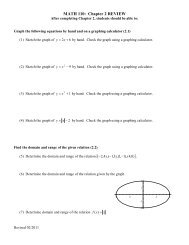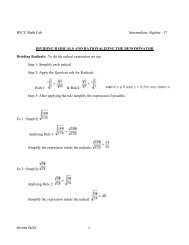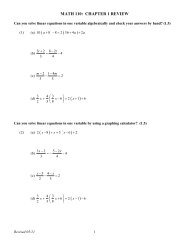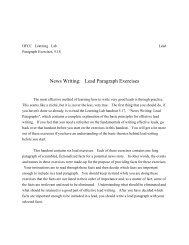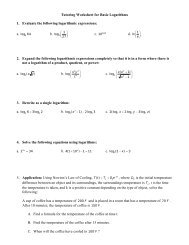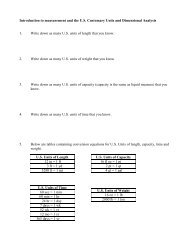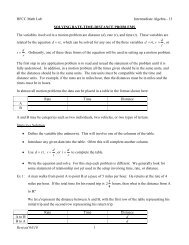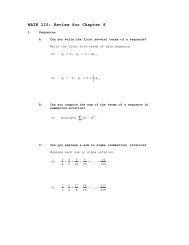Factoring ax^2+bx+c, a is not 1 - The Learning Lab at HFCC
Factoring ax^2+bx+c, a is not 1 - The Learning Lab at HFCC
Factoring ax^2+bx+c, a is not 1 - The Learning Lab at HFCC
You also want an ePaper? Increase the reach of your titles
YUMPU automatically turns print PDFs into web optimized ePapers that Google loves.
Step 5: ( 8x1)( x 6)= − − Factor out the resulting common binomialfactor ( 8x − 1)ANSWER:3 216 98 12x x x− + = 2x( 8x 1)( x 6)− − .3) Factor26x19x10+ + completely:FIRST: check for COMMON FACTOR among the coefficients or the variables.In th<strong>is</strong> case the COMMON FACTOR <strong>is</strong> 1. <strong>Factoring</strong> 1 out will <strong>not</strong>simplify the problem.NOTE: a = + 6, b = + 19, and c = + 10Step 1: Find the product: ac = ( 6)( 10)= 60Step 2: Find m, n where m • n = 60 and m + n = + 19 , herem = + 4 and n = + 15Step 3: Rewrite the trinomial using the two integers from step 2 to break up themiddle term.26x+ 19x+ 102= 6x + 4x + 15x+ 10 Split the middle termStep 4: 2x( 3x 2) 5( 3x2)= + + + Factor the GCF from the first two terms andStep 5: ( 3x2)( 2x5)Factor the GCF from the second two terms= + + Factor out the resulting common binomialfactor ( 3x + 2)ANSWER:26x19x10+ + = ( 3x2)( 2x5)= + + .4) Factor26x19x10− + completely: ( Compare th<strong>is</strong> to example 3)FIRST: check for COMMON FACTOR among the coefficients or the variables.In th<strong>is</strong> case the COMMON FACTOR <strong>is</strong> 1. <strong>Factoring</strong> 1 out will <strong>not</strong>simplify the problem.NOTE: a = + 6, b = − 19, and c = + 10Rev<strong>is</strong>ed 03/09 3




